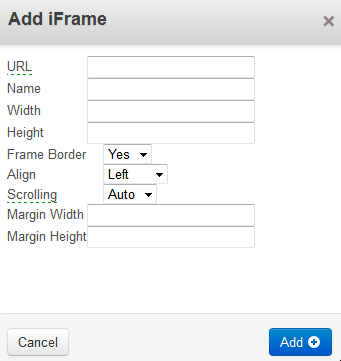

Even if that value would somehow be changed to another of the list of possible values, it makes no difference security wise.This document explains how to embed a YouTube player in your application and also defines the parameters that are available in the YouTube embedded player.īy appending parameters to the IFrame URL, you can customize the playback experience in your application. I control the value from sending and receiving end (meaning I check if the value is of correct type and from a list of possible values). Oh actually I do send an integer value from to parent. Then in Map.PHP I simply loaded jQuery.old and Map.JS and the rest is history. Now what I did is, I placed a responsive container where the Map.JS should be, and placed to Map.PHP in it, and set the to width: 100%, height: 100%. This, let’s call it Map.JS, is dependent on an older version jQuery (this is the part where I don’t deem this best, because the jQuery version in question has a few know vulnerabilities, but let’s say for example, that we could use the latest jQuery version). But per a certain request, one site needed to use a map somewhat similar to gMaps, but very different in other ways that are essential. In the last few years I made a real effort to rid our websites from jQuery. This is more of a hack that I don’t deem best, but didn’t see a quick way around while on tight schedule. Loading embeded video or similar from trusted sites like YouTube and gMaps. I use in two different scenarios and both seem mostly fine to me. And the kind of thinking that lies behind prohibition that you’re supporting has cost me money with no appreciable benefit. Do you really stand by your absolute prohibition on iframes? I am not planning on linking to other sites only to a generated page on the same server and website.
IFRAME NO BORDER PROFESSIONAL
The guy who did this was obviously a professional but I’m now stuck with a program that I paid for but can’t use. Needless to say, this would result in a highly rigid, ungainly system that would make editing a nightmare. If I wanted the same look and feel on pages created with his software, I had to link to style sheets at the appropriate part of the site. They went into a special folder that I could securely control from my computer.
IFRAME NO BORDER PLUS
The developer insisted (to the point of nastiness) that iframes were not secure and created a system whereby I could create whole web pages (HTML plus embedded animations) but couldn’t put these pages in their appropriate folders on the site. I wanted to import the generated animations into webpages on my site using iframes. This was uploaded to a specific folder on my site. I recently had a developer create a method of making animatable text which involved using css, javascript and a database. I strongly advise you stay away from using the iframe tag. You might manage to rectify it now, only for you and your visitors to get problems with Google, usability, or security later. You may be facing what seems like a small layout issue with your iframe tag today. Create pages that Google can crawl and associate with your site easily. If you do include iFrames, make sure to provide additional text-based links to the content they display, so that Googlebot can crawl and index this content. We recommend that you avoid the use of iFrames to display content. Content displayed via iFrames may not be indexed and available to appear in Google’s search results. IFrames are sometimes used to display content on web pages. Google recommends refraining from creating iframes.Īt there Webmasters Help Forum, Google clearly stated that iframes may cause problems for them : Every in a page requires increased memory and other computing resources.įind better ways to refer your visitors to external content instead of placing it within the iframe tag.Navigation of the site in the iframe stops working.Content within the iframe is missing since the source URL changed.Content within the iframe doesn’t fit in and looks odd.It confuses users, suddenly opening the iframe content in a new browser window.It confuses visually impaired visitors, using screen readers.It tends to break the browsers’ “Back” button.The iframe tag is notorious for creating usability annoyances. A malicious user can hijack your users’ keystrokes.ĭon’t put your visitors at risk to the XSS attacks.A malicious user can hijack your users’ clicks.A malicious user can change the source site URL.You may get a submittable malicious web form, phishing your users’ personal data.If you create an iframe, your site becomes vulnerable to cross-site attacks. In this blog post, you will learn the three main reasons why you might not want to use the iframe. It often creates more problems rather than solving them.īreaking design is not the only issue with this tag. They right away bumped into a layout issue. One of our customers implemented an iframe on their website.


 0 kommentar(er)
0 kommentar(er)
